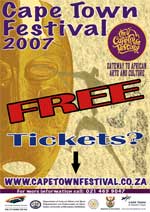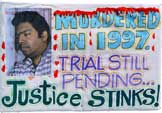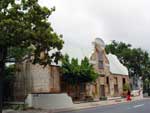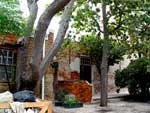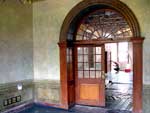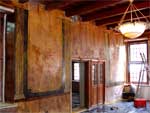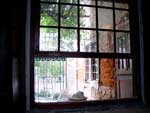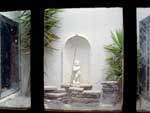The Ghost of Kronendal
|

|
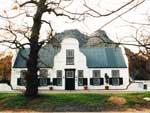 Kronendal ca. 1990
Kronendal ca. 1990
(courtesy of Klaus Gautier)
|
For close on 170 years reports have circulated about Kronendal’s “friendly ghost.” The most recently recorded sighting was just before Christmas, 1999, but there could have been other sightings since, which have not been reported in the media.
The legend of the ghost dates back to 1840, about 40 years after the present gabled manor house was built around 1800.
The story goes that the manor house and Kronendal farm were owned for a short time during that period by the Cloete family.
The owner, Daniel Cloete, had a very pretty daughter, Elsa. She fell in love with a soldier from a British garrison stationed in Hout Bay. However, their love was forbidden since he was British and she was Dutch.
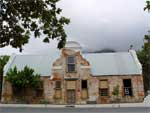 Kronendal under renovation during the 1st quarter of 2007
Kronendal under renovation during the 1st quarter of 2007
|
The closest contact they had was at secret meetings at the front windows of the homestead. Eventually, in desperation, the soldier hanged himself from one of the oak trees in the avenue across the road from Kronendal that can still be seen today. Elsa, it is said, died of a broken heart.
Around sunset, they say, you can sometimes see a man standing among the oaks looking longingly at the Kronendal building and every so often there is a young woman wearing an old-fashioned blue dress looking out of one of the windows. Elsa’s ghost has also been seen frequently in the building itself.
In 1999, during a time when the Kronendal building was being used as a restaurant, the owners at that time took to setting a table for two for Elsa, which they did not allow anyone else to use.
On Tuesday, December 15, a visitor from England – an architect – saw a woman dressed in a blue top, grey pinafore and a bonnet. He remarked to his wife: “What a funny hat that woman is wearing.”
He watched the woman sit down at the table, then she got up and walked to the scullery.
According to Pia Pameissl, the public relations officer for the restaurant at that time, the English visitor thought she was the apparition and had dressed up to play a practical joke on him and his wife.
“I convinced him I had not done so and then I told him the legend of Elsa,” said Pia. “We all thought he was joking about seeing her and we asked him how much he had had to drink. But his amazement was too real to be faked.”
Since the 1970s there have been at least five documented sightings of Elsa’s ghost, reported in local newspapers and magazines.
|
|
Cape Point Route Marketing Workshop – Weds 7th Feb 2007
|

|
|
By Sally Grierson
 View from Monkey Valley overlooking Noordhoek beach up to Kommetjie
View from Monkey Valley overlooking Noordhoek beach up to Kommetjie
|
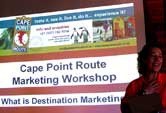 Barbara from CPR opening the workshop
Barbara from CPR opening the workshop
|
It was a blistering summer afternoon on the Cape Peninsula, so it was a real pleasure to arrive at Monkey Valley Resort and the cool shade of the ancient Milkwood trees that surround the resort. Cape Point Route was hosting a destination marketing workshop and it was not hard to conceive of the destination as we gazed at a long stretch of white sand and sparkling sunlight dancing on the blue waters of the Atlantic. An all too easy distraction from the workshop task at hand.
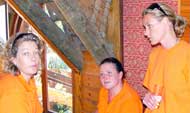 CPR team, l.t.r.:
Barbara, Kelly & Sally
CPR team, l.t.r.:
Barbara, Kelly & Sally
|
Except it wasn’t a task at all and we were absorbed by the friendly welcome of the Cape Point Route team – a reflection of the warmth and hospitality that the Cape Peninsula region is known for offering the visitor.
The programme for the afternoon was kicked off with a welcome by Barbara Elshove- Schmidt and introduction to her partner Sally Grierson who spoke on destination marketing as a whole.
The gist of the entertaining talk was for the 40 odd participants to understand that every destination requires a “travel hook” like a Taj Mahal in India or an Eiffel tower in Paris. The destination adds to the profile with niche attractions, events, activities and offerings to make the area worthwhile for a visitor to choose over another option. It was imminently clear that the Cape Point Route has Cape Point Nature Reserve as its main attraction with an enviable number of lively coastal villages, beaches, natural resources, activities and events to hold a visitor captivated for many days and the Cape Point Route slogan “worth more than a one night stand” is definitely worth abiding by! The region is so much more than a day trip from Cape Town city Centre despite its proximity. Sally reinforced to the attendees
that travelers rarely choose their destination based on the accommodation establishment and urged all accommodation owners and products in the area to work closely together to keep guests in the region. This method enhances sustainable economic growth for all business in the area.
Jodi McMeeman from GeoSavvy .....
|
|

Q & A on Filming in the South Africa
|
 by Mark Visser
by Mark Visser |
|
Why Film in Cape Town/ Western Cape?
Cape Town’s peak summer season not only makes it a key spot for local and international tourists but also for film. City roads and beaches literally light up with film shoots, camera cranes, swimsuit models and even a few international celebrities. However the Western Cape film industry has benefits beyond spotting a celeb or two.
The high production values and developed film infrastructure on which Cape Town and the Western Cape has built its reputation are complemented by spectacular locations, sunny weather (in the Northern Hemisphere’s winter) and 14-hour days of radiant light. Beyond the excellent facilitation services available to productions, South African crew are also renowned for their high standard of skill in the production environment.
Although in recent years, the enchanting Cape Town has become the centre of the international production industry, the city is also the perfect launch pad to a variety of exotic locations in Southern Africa and the Indian Ocean Islands, many of which enjoy an equable annual climate. Other areas of location production such as Gauteng and KwaZulu-Natal also offer wonderfully contrasting landscapes. Cape Town alone has doubled for a multitude of international locations, beyond representing it’s own natural beauty.
Milestones?
Cape Town has been the choice destination for a number of recent big budget films. These include Blood Diamond, Roland Emmerich’s upcoming epic adventure “10 000 BC”; the upcoming “Disgrace” starring John Malkovich; “Ask the Dust” with Slama Hayek and Colin Farrell and Director William Niccol’s $50 million “Lord of War” starring Nicholas Cage, Jared Leto and Ethan Hawke. The film incorporated some 19 different key locations in Cape Town, standing in for other parts of Africa and the world.
Cape Town has also had great success with co-productions. Charlie Jade, the sci-fi series that has received much international acclaim was a co-production between South Africa and Canada. South Africa also shares co-production treaties with Germany, the United Kingdom, Italy and a Memorandum of Understanding with India.
Locally, South Africa has shown it’s worth with the Oscar winning “Tsotsi”; “uCarmen eKhayelitsha”, which won the Golden Bear at the prestigious Berlinale Film Festival in 2005; “Dollars and White Pipes” and “The Story of an African Farm.”
Challenges?
One of the reasons Cape Town’s facilitation services are so renowned is that our professional English-speaking crew, get the job done, efficiently overcoming every possible obstacle. Being at the Southern most tip of the African continent puts Cape Town in a very remote position in terms of the world’s leading film industries. However, cost comparisons and a favourable exchange rate have still made Cape Town one of the most affordable production destinations in the world. Lobbying to city and regional government representatives, Cape Town’s Film Commission has managed to bring down the cost of film tariffs for public spaces by 50% during the 2005/2006 season and will see the City of Cape Town officially wavering film tariffs for all public locations within the city.
Other challenges the Cape Town film industry faces is lack of necessary skills, which through numerous projects that the Cape Film Commission has been engaging in over the past two to three years, is being addressed very successfully.
The Western Cape Film Industry’s current position?
Cape Town and the Western Cape film industry is considered one of the leading international commercial production destinations in the world and has seen an immense increase in feature film production over the 2005/2006 financial year. The region’s industry contributes some ZAR 3.5 billion to South Africa’s Gross Domestic Product and provides an average 6 850 full time jobs which is set to double over the next four years.
The future of the Western Cape Film Industry?
With the attention of the world turning to South Africa for the 2010 World Cup, cape Town will be engaging in numerous efforts not only to accommodate media and commercial industries leading up to the World Cup Soccer, but also to reach new production highs following this international event. The industry is steadily becoming noticed on all business, government and public fronts as a serious and beneficial industry set to provide immense spin-offs for the tourist, hospitality, catering, equipment rental, private and transport sectors.
The Cape Film Commission?
 Laurence Mitchell
Laurence Mitchell
Commissioner
|
 Bianca Mpahlaza
Bianca Mpahlaza
Public Relations
|
The Cape Film Commission as the official representative of the film industry for the City of Cape Town has as its mandate not only to market and promote Cape Town and the Western Cape as a leading production destination but also fosters the economic development of the Western Cape’s film industry. The CFC has set in motion a strategy based on the three pillars of growth, integration and transformation. The CFC's vision is to position the Western Cape and Cape Town as a globally competitive film destination, thereby creating sustainable jobs and business opportunities, boosting tourism, and developing core skills.
The CFC has achieved this through various undertakings, working with local and provincial government as well as the public and private sectors, forming valuable partnerships that not only promote the industry but also skills development and preparation for a rapidly growing industry. The CFC achieves this by:
 CFC Impact Assessment Report Breakfast Briefing
CFC Impact Assessment Report Breakfast Briefing
Cape Town, Arabella Sheraton
02 March 2007
|
- Marketing the Cape film industry internationally, nationally and locally via hosting of national and international delegations, international trade shows and expos.
- Facilitating investment and developing the film industry in the Western Cape and Cape Town by engaging potential interests and providing support and serving as a central point for all film related information.
- Providing logistical support, guidance and advice to the film industry regarding production in the region.
PDF Document:  Summary Summary
Slide Show:  Impact Assessment Report Impact Assessment Report
For more information regarding filming in the Cape Town and the Western Cape, contact the Cape film Commission:
|
|
|
Write The Screenplay Of Your Dreams
Everyone has a story to tell. Not just a little gossip to spread around, but a story that is bigger than life and will hopefully be told to millions on the big or small screens, on film or television.
If you are one of those who want to see your dream of becoming a screenwriter realised, simply want to write better films that the ones you watch, or write the ultimate South African film that will place our industries on the world map, there's only one place to start.
It starts with writing the screenplay, and if that sounds like a daunting task, The Writing Studio will make it as easy as baking a pie.
 Daniel Dercksen
Daniel Dercksen
|
Since The Writing Studio was launched eight years ago trainer Daniel E. Dercksen has presented over 200 workshops in scriptwriting and creative writing throughout South Africa. As a published playwright, writer and movie journalist, he is a qualified ETD Practitioner (Education, Training and Development) - accredited by SAQA (The South African Qualifications Authority) - working in accordance with the principles of the Department of Education and focusing on outcomes-based education, training and development, and has been involved in movie journalism for more than 25 years.
The Writing Studio gives you plenty opportunity to flex your creative muscle. You can hone your craft by attending one of the workshops held in Cape Town on a regular basis, or in Johannesburg, or if you feel pressed for time and prefer to work in your own space and at your own pace, there's even a correspondence course to suit your needs.
Writing the screenplay is not the end of the process. Once The Writing Studio has honed your skills, there's an advanced workshop where writers complete a draft of their screenplay. And, once you have a draft ready, then it's time to hand it over to The Write Agency, where a group of professional readers will deliver feedback.
 Script Writer class at the SABC in Cape Town
Script Writer class at the SABC in Cape Town
|
Once your script is ready for the marketplace, where producers are constantly searching for South Africa's next Oscar winner, The Writing Studio and The Write Agency will then help you to start working on your next script. Before you know it your name will be on posters worldwide and your dreams will be experienced all over the world.
Creative Writing Workshops are aimed to improve the writing skills of those who would like to write the short story, novel, or article of their dreams. Writers will look at the stages and process of creative writing, different types of creative writing and how to write for different mediums - ranging from fiction, non-fiction and journalism. Short Stories written during the workshop will be forwarded to readers of The Write Agency.
As one of the leading Independent Training Initiatives in Africa, The Writing Studio has been actively training writers for 8 years throughout South Africa. Interested?
|
|
|
By Thomas Mihal, Positive Imaging
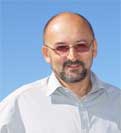 Thomas Mihal
Thomas Mihal
|
One of the terms that popped up during the rapid changes in visual communication is Colour Management. Artists, photographers, publishers, printers anybody who makes or uses pictures and graphics in a digitized format, talks about colour management.
But what is it really?
Some people think immediately of expensive software packages and even more expensive calibration equipment; others of well kept secrets only to be known by the members of an exclusive brotherhood of the initiated few.
We see a confusing variety of colour strips, and wedges, fancy patterns and patches, grey scales and control patterns with even more confusing brand names. They appear next to images on screens, proofs and prints to be evaluated by the matching calibration goodies who either feed the information magically back into some computer who in turn makes the necessary adjustments to the colour and tone values or you will be provided with some figures and data which will allow you to make accurate adjustments to the camera , printing machine, screen or the image itself … as long as you are able to interpret the data correctly and know how to apply it.
To me this is all a bit abstract. Visual communication is a creative field and most involved people are more intuitive then calculating by nature. The whole thing reminds me of the vast range of diets designed to make you loose weight. There are hundreds of different approaches just as many different methods a lot of them contradict each other and very few of them work.
So instead of subscribing to a program that includes a range of products and videos that come with a T-shirt and a membership card , it might be better to just eat less and run twice around the block every day; my point is : We must not loose sight of the actual reason for colour management.
First: What do we want?
We want an image that is true in colour, has contrast and density
Second: What is true ?
The original creation
Third: What is the end product ?
It could be a
· presentation using a digital projector
· photographic print
· digital image displayed on a screen
· digital print
· litho print (printed publications)
· e.t.c.
The aim of colour management is to make your final product look exactly like the image initially chosen. It starts with the artists choice of colour, the photographers choice of film, aperture and shutter speed. If digital photography is used then the choice of file format comes already into play.
Now we have the original creation.
The next step is, to turn the image into digital form (except if a photo has been created using a digital camera). This can be done by scanning or digital photography.
Colour management is crucial at that point because any deviation from the original will result in a loss of quality along the way. The digital image can be one of many file formats, the most popular being JPG and TIF.
At that stage the image must be adjusted to counteract the effect of any further processing; for example:
A model on a beach is to appear in a newspaper that is printed on matt, soggy paper: The white sand will have to be made purposely too bright because the paper is not pure white to start of with. The soft shadows on her body will have to be adjusted to a much paler tone to compensate for the spreading of ink during the printing process. A presentation using a digital projector will need a different range of light and colour then the same presentation on a website.
Art reproductions and books have a long established culture of colour management , In the past a large part of the production time and budget was spent on colour correction and retouching. This was done manually with chemicals by etching the plates or films one colour separation at a time. This process is now being done electronically, but it still needs the expertise of someone who knows the printing process. To do all this many programs have been written and every modern printer uses “profiles” which can be applied to proofing devises and print files.
If the artist, the photographer and the designer want to avoid disappointment and see their creations not compromised by technical limitations, there are a few points to be considered:
 Johannes Itten (1888-1967):
Johannes Itten (1888-1967):
Colour Table
|
- Don’t trust your computer screen for colour and brightness. Always have a test image resident on your hard drive in digital form, and the same image as a print somewhere where you can se it. This will allow you to evaluate any new images on your screen; even with a calibrated screen.
- Make sure your colour proofs are of good quality. A true proof does not mean pretty pictures. If the print is meant to be a proof it has to show the actual tonal and colour values without flattering and enhancing (unless the print is the final product). Some digital printers use additional inks to achieve colour tones that a conventional litho press for example cannot achieve.
- When going to litho, print work in CMYK. Some colours (light greens and bright oranges) look brilliant on your screen in RGB but loose a lot of their glow when printed in the process colours ( Cyan, Magenta, Yellow, Black).
- No reproduction can be better than the original. It is quite amazing what can be done to an image using program like Photoshop e.g. but the range of the original will always be compromised by corrective work.
- Trust your eyes more then technical data. Keep a colour control strip with your original during photography and proofing. Compare the original control strip with the ones on the subsequent proofs. But look only at the picture at the final stage.
Problems usually come only with corrective actions, more care at the start will prevent disappointment at the end.
|
|
The Cape Town Festival
|
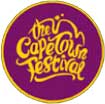
|
|
By Yvette van Breda
South Africa’s mother city’s premier arts event sees more than 100'000 fest-goers attend over 140 shows during its annual three-week run in March.
A cultural expression by the people of Cape Town, the Cape Town Festival (CTF) showcases the talents and excellence of various cultures, both local and international, to depict not only our uniqueness but also to highlight our common humanity through the arts.
CTF uses and promotes over 50 venues in and around the city including the Artscape Theatre, the Baxter Theatre, Intimate Theatre, Joseph Stone Auditorium, Distrix Café, Manenberg Jazz Café, On Broadway, and Durbanville venues, Die Kunskafee, Durbanville primary, On Broadway, the city’s Company’s Garden Precinct; Iziko Museum venues, V&A Waterfront's Amphitheatre; Manenberg Jazz café, UCT sports Complex; Grand West Casino.
The CTF has successfully established several brands under its banner like the CT International Performing Arts Festival, the Short Film Festival, the CT Youth Festival, Hip Hop Festival, Local goes Vocal, Jou Ma Se Comedy and the Cape Town Street Festival – a popular multi-dimensional event, now incorporating its predecessor Night Vision and centred in the city’s sealed-off-to-traffic Long Street. It becomes a mish-mash of fashion shows, live performances, music, art, galleries, lazer displays and PARTYING (jolling) at the numerous clubs and pubs. The daytime segment was added to cater for families, promoting art to the youth, and creating entrepreneurial and business opportunities for traders by day. Some 30000 festival-goers cash-in on the extraordinary energy of this exciting festival event.
 Esther Henderson
Esther Henderson
Marketing Manager
|
 Yusuf Ganief, CEO
Yusuf Ganief, CEO
|
With Festival brands like the CT International Performing Arts Festival, the Short Film Festival, the CT Youth Festival, Hip Hop Festival, Local goes Vocal, and Jou Ma Se Comedy successfully established under the Cape Town Festival banner, the focus will be on consolidating the standard of these productions, to grow the international cultural exchange programme and to foster new partnerships with tourism and 2010 initiatives, streamlining the festival with all the major players in the city.
With the advent of the Cape Town International Performing Arts Festival in 2004, the Festival truly became an annual event celebrating diversity and promoting cultural understanding on the global map. An event that not only serves as an international entertainment platform, but also as an annual income opportunity for many of the city’s professional and emerging artists and a tourist-attracting event which brings much appeal to our growing tourist industry.
|
|
| South African’s Unite Against Crime |
|
By Farhaana Allie

Farhaana Allie addressing the Government
|
South Africans Unite against Crime (SAUAC) is a not an organization but consists of a group of concerned citizens who want to be proactive in assisting government to make a change to the criminal activity that faces us each day. As South Africans there is a need for us to be heard and more importantly to be taken seriously.
On Saturday, 10 March 2007, a National March took place in Johannesburg, Durban and Cape Town at 10h00. The aim of the march was to hand over to Government a National Mandate and urges our leaders that the correct steps are taken to ensure change with regard to crime, criminals and the judicial system in South Africa.

Pastor Basson
|
The march in Cape Town started off in Keizergracht Street and preceded to parliament, however the response in numbers was not good; it was the atmosphere that made the impact. Children lead the march and their plight of was a strong focus point within the mandate.
The march saw the citizens opening up to the various incidences of crime and how it has impacted on their lives. The programme gave an opportunity to the children to speak-up about how they view crime in this country and they highlighted how crime has affected their lives directly.
 Nomahlubi Mgijima
Nomahlubi Mgijima
receiving the Mandate from Farhaana Allie
|
The Mandate was received by Ms. Nomahlubi Mgijima from the Department of Community Safety at Parliament. She indicated that she would forward the National Mandate to the correct person within Government and SA Unite Against Crime will follow-up closely on this matter. Progress will be communicated with the citizens.
It is important to note that SAUAC is not represented to Victims in the Republic of South Africa (VIRSA), as VIRSA was kind enough to host the information of SAUAC on their website.
Pastor Johnny Basson formally opened and closed the processions and emphasized how important it is for all to work together in order to combat the evils of crime. This crucial initiative is to ensure that the building blocks are put into place to provide safety and security to all as part of our human right.
|
|
| INDABA – Question & Answers |

|
|
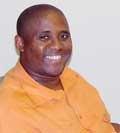
Linda Mase
Destination Development Coordinator
|
Q. What is it all about?
A. Indaba is the biggest tourism exhibition in Southern Africa and creates a platform for companies from all over South Africa and the SADC regions to showcase their new, existing and innovative tourism and hospitality products and services to the international tourism trade.
Q. What are the objectives?
A. To showcase South Africa and SADC tourism offerings, Create networking platforms, Learning environment for product development and innovations
Q. Why is this necessary?
A. It’s the only big platform in Southern Africa that brings local tourism products/services close to the international markets
Q. Who are the players?
A. Provinces, SADC Countries, Accommodation sector, Tour Operators, Travel Agents, Tourism Attractions, Governments Departments – DEAT & DTI
Q. Who should visit?
A. Trade buyers and wholesalers, Media, Students and Public
Q. Where does it take place?
A. Durban International Convention Centre
Q. What else could one do and see while visiting?
A. Cultural Exhibition and Activities, New Products in the market, Craft Market etc
This years INDABA: 12th - 15th May 2007
|
|
|
|
 No. 016-01
No. 016-01
|
This Month Welcome Page
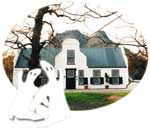 |
Hout Bay Khoisan Cultural
Heritage Centre
A project by
Sentinel Experience
|
|
riempie vasmaak
mixed media exhibition by
- Manfred Zylla
- Roderick Saul
- Garth Erasmus
- Andrew Emdon
28 February - 31 March 2007
ERDMANNCONTEMPORARY
63 Shortmarket Street, Cape Town 8001, South Africa
Gallery Hours Tue - Fri 10:00-17:00 & Sat 10:00-13:00
|
|
|

Manfred Zylla
| |
|

Garth Erasmus
| |
|
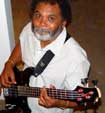
Roderick Saul
| |
|

Andrew Emdon
| |
|
 Exhibition Opening Exhibition Opening
| |
|
Distribution:
Our e-News are distributed to arts & culture, the film, stills & commercial industry, wildlife, heritage, companies servicing and attracting tourism ( tourist offices, travel agents, tourist guides & tour operators) locally and abroad as well as to people who have an interest in visiting South Africa.
Published by

To ADVERTISE in this Newsletter
 news@onsetimages.com or call 021 790-2227 news@onsetimages.com or call 021 790-2227
Alternatively send us your CONTACT INFORMATION
Print Newsletter (note: set to landscape format) 
|
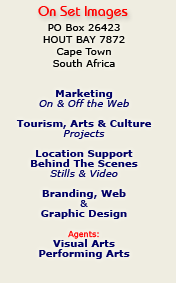
|
|




























